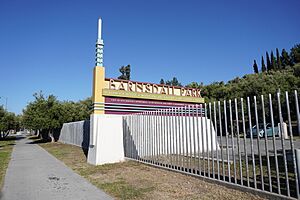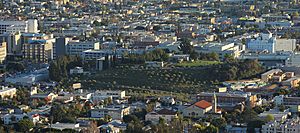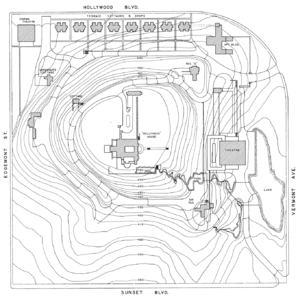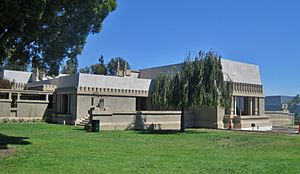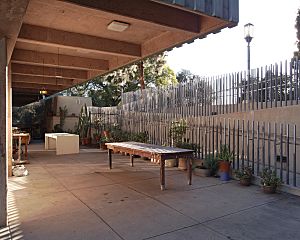Barnsdall Art Park facts for kids
Barnsdall Art Park is a special city park in the East Hollywood area of Los Angeles. It's a place where art, nature, and history come together. You can find it on Hollywood Boulevard.
This park is a Los Angeles Historic-Cultural Monument, which means it's an important historical site. A group called the Barnsdall Art Park Foundation helps take care of the park and all the fun activities there.
The park was a gift from a woman named Aline Barnsdall. She gave it to the City of Los Angeles so people could enjoy art and recreation. It's on top of a hill called Olive Hill, offering amazing views of Los Angeles and the Hollywood Hills. The most famous building in the park is Hollyhock House, designed by the famous architect Frank Lloyd Wright. It's a landmark and even a World Heritage Site!
Contents
Park History
The land where Barnsdall Art Park now stands was once owned by Aline Barnsdall. She was an oil heiress who dreamed of building a place for arts and live theater. Before she bought it, the hill was covered with olive trees planted in the 1890s. Even though it was near streetcar lines, developers weren't interested because it wasn't close to Downtown Los Angeles or central Hollywood.
Aline Barnsdall met architect Frank Lloyd Wright in 1915. She first hired him to design a theater in Chicago. But after visiting California, she decided to build her theater there instead. Barnsdall bought Olive Hill in June 1919. Wright then started designing her house and theater. Over time, plans changed, and by 1923, the theater idea was dropped. Only two guest houses were built, and only one of them still stands today.
How the Park Land Was Acquired
In December 1923, Aline Barnsdall offered to give Hollyhock House to the city. She wanted it to be used by the Los Angeles Public Library and the Department of Recreation and Parks. This gift included about 10 acres of land at the top of Olive Hill. The city first said yes but then changed its mind in early 1924. They felt her rules for the gift were too strict.
Barnsdall later offered the house and land to the city again, this time with fewer rules. The city of Los Angeles accepted her generous gift on December 22, 1926. This land became Barnsdall Art Park. The Los Angeles Times newspaper wrote that the site was "beautiful and perfect for a playground." For 15 years, the California Art Club used Hollyhock House as their meeting place.
In 1927, Barnsdall suggested building a Greek amphitheater in the park. It would have 1,000 seats. This outdoor theater, called the Little Lattice Playhouse, opened in June 1927. That same year, Barnsdall gave another building, Residence A, to the city. It reopened as a recreation building in February 1928. A playground was also added to the park around this time. In 1929, the city decided to add decorative lamps around the park, which were lit up the next year.
Park Changes in the Mid-1900s
In the 1930s, Barnsdall offered more land to the city. There were some disagreements about taxes and other issues, but the city eventually agreed to lease more land. Lloyd Wright, Frank Lloyd Wright's son, designed a children's theater and a wading pool for the park.
Over the years, there were some disputes between Barnsdall and the city about the park's ownership and access. By 1941, a judge decided that Barnsdall could keep Residence B, while the city would keep Hollyhock House and the rest of Olive Hill. Barnsdall kept Residence B until she passed away in 1946.
In the mid-1940s, the park needed some care. Local residents helped clean it up in 1948. There were also ideas to expand the park and add more land.
Park Development from the 1950s to Today
In the 1950s, parts of the park's edges were developed with shops and apartments. A hospital was also built nearby. Frank Lloyd Wright was hired again to design an art pavilion next to Hollyhock House, which opened in 1954. Residence B was taken down that same year. The annex to Hollyhock House became the Municipal Art Gallery in 1956.
In the 1960s, more parts of the park were redeveloped. A new plan for the park was made in 1964, suggesting new buildings like a junior art center and an auditorium. The Junior Art Center opened in May 1967. A new Municipal Art Gallery was also planned and opened in March 1971. However, plans for other buildings were canceled because there wasn't enough space for parking.
In 1985, a group suggested that the city plan for the park's future. The city started renovating the park in 1986. In 1989, a sculpture garden was created, and a new watering system was installed for the olive trees.
In the early 1990s, the Los Angeles County Metropolitan Transportation Authority built the Metro Red Line (now the B Line) subway under Hollywood Boulevard. They used part of the park for construction. After the 1994 Northridge earthquake, a new plan was made to improve the park, including better access, new fences and lights, and replanting olive trees. The first phase of these improvements finished in 2003.
In 2020, the park temporarily closed to the public because of the COVID-19 pandemic in California. In 2021, the Barnsdall Art Park Foundation began working to restore the park's olive groves. Both Hollyhock House and Residence A were also restored. Hollyhock House reopened in August 2022. The Barnsdall Arts Center reopened in July 2024.
Park Description
Barnsdall Art Park covers about 11.5 acres of Aline Barnsdall's old Olive Hill estate. It's located at 4800 Hollywood Boulevard. When the park was given to the city, it had many olive trees, along with other plants like oleanders and hibiscus. The park has paved paths and parking areas at the bottom of the hill.
Because it's on a hill and has many art venues, the Los Angeles Times newspaper once called Barnsdall Art Park the "Acropolis of Los Angeles." Besides art shows, the park also hosts fun events like Friday-night wine tastings for adults.
Hollyhock House
The most famous building in the park is Hollyhock House. It sits on the northern side of Olive Hill. This house was the first project in Los Angeles for architect Frank Lloyd Wright. Built between 1919 and 1921, it shows his early ideas for a unique style of architecture for Southern California. The house is designed to blend indoor and outdoor spaces, perfect for the mild climate.
Hollyhock House gets its name from the hollyhock flower, which was Aline Barnsdall's favorite. Wright used abstract hollyhock patterns throughout the house.
Frank Lloyd Wright was often away working on another big project in Japan. So, his son Lloyd Wright and his apprentice Rudolph Schindler helped oversee the building of Hollyhock House. Both of them later became famous architects themselves. Hollyhock House is a Los Angeles Historic-Cultural Monument, a National Historic Landmark, and a World Heritage Site.
Other Buildings and Features
Residence A is located slightly south of New Hampshire Street and Hollywood Boulevard. North of Hollyhock House is the garage building, which also had a home for the chauffeur. Residence B used to be on the western side of Olive Hill but was taken down.
The Spring House, on the southeastern side of Olive Hill, was once a refrigeration building. Near it is Schindler Terrace, where a community theater was planned but never built. The Junior Arts Center is also close by, southeast of Hollyhock House. The Los Angeles Municipal Art Gallery is north of the Junior Arts Center, on the eastern side of Olive Hill.
Los Angeles Municipal Art Gallery
The Los Angeles Municipal Art Gallery is a large space, about 10,000 square feet, for art exhibitions. It was finished in 1971. It shows big group exhibitions and special shows of individual artists' work. The Junior Arts Center Gallery is a smaller space, about 2,000 square feet, within the same building. Sometimes, both galleries are used together for very large exhibitions.
The Municipal Art Gallery usually has about nine exhibitions of contemporary art each year. They show paintings, sculptures, photographs, and other types of art. More than 45,000 people visit the exhibits at Barnsdall Park every year.
Barnsdall Gallery Theatre
The Barnsdall Gallery Theatre (BGT) has 300 seats. It's managed by the City of Los Angeles's Department of Cultural Affairs. This theater can be rented by individuals and groups for plays, dance shows, music concerts, talks, movies, and other events.
BGT also hosts many community events, including free programs. These include performances by the Independent Shakespeare Company, music summer camps by the Silverlake Conservatory of Music, and annual festivals like the Thai Festival.
Independent Shakespeare Company
The Independent Shakespeare Company (ISC) puts on free live summer shows on an outdoor stage in the park.
In 2004, the ISC started performing at Barnsdall Art Park. Their first play was The Two Gentlemen of Verona. They also performed Richard III and Hamlet. They became very popular and eventually needed a bigger space. In 2010, they moved their free Shakespeare series to Griffith Park.
Silverlake Conservatory of Music
The Silverlake Conservatory of Music offers Music Summer Camps at the Barnsdall Gallery Theatre. Professional musicians teach young people about music. They perform their music and explain how different instruments work together. This helps young people who are interested in a music career learn from experts.
Barnsdall Art Center
The Barnsdall Art Center offers art classes for adults at a low cost. A student group helps support the center and its growth. This non-profit organization also provides volunteers and financial help for programs and classes that the city can't fully fund.
The Junior Arts Center
The Junior Arts Center offers art programs for children and young people aged 3 to 18. Since 1967, it has been in a building designed by Hunter & Benedict and Kahn, Farrell & Associates. Classes include drawing, painting, film making, printmaking, acting, photography, and sculpture. There are also classes where parents and children can learn together. The center has a special gallery that shows art made by young artists.
The Junior Arts Center Gallery features art for families, including works by both children and adults. It also has interactive exhibits. Special events held each year include Día de los Muertos, Aline Barnsdall Day, and student art shows.
See also
- List of Los Angeles Historic-Cultural Monuments in Hollywood
- List of parks in Los Angeles
- Little Armenia, Los Angeles — a community nearby
- Lloyd G. Davies — a former L.A. City Council member who wanted to expand the park


